The Spirit of Luxury – 100 years of Schmohl AG in Zurich
When Schmohl & Co. opened its doors in Zurich in 1923, there were more horse-drawn carriages on Swiss roads than cars. Motorised vehicles were only for those who could afford them. Schmohl AG has retained this sense of exclusivity to this day – by selling experiences, not cars.
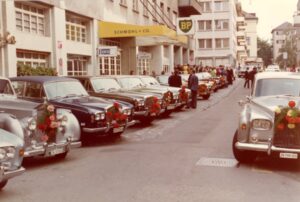
1923: From a cartwright to a car dealer: The foundation of Schmohl & Co.
On 2 June 1905, Georg Friedrich Schmohl, a native of Nürtingen in Baden-Württemberg, was granted citizenship of the city of Zurich, giving him and his family Swiss citizenship. Mr Schmohl lived with his family of nine in the working-class neighbourhood of Wiedikon in Zurich and earned his living as a cartwright, i.e. a wheelwright and carriage builder. And like his father, his eldest son, Karl Julius, born on 7 February 1888, was also enthusiastic about wagon building – albeit modern wagon building, the one with horsepower inside the engine instead of the carriage. According to the 1915 Commercial Gazette, he was promoted to authorized signatory of the Olten-based Berna motor vehicle factory, which manufactured lorries and tractors for the Swiss army, among other things. Julius Schmohl even became the company’s director in 1920. Three years later, he ventured into self-employment and founded Schmohl & Co. in Zurich on 15 April 1923. The purpose of the company is the “manufacture, remanufacture, inspection and repair of automobiles, automobile operation, trade in automobiles and components”. The company was located on what was then the very outskirts of Zurich at Brunaustrasse 93/95 – the tracks of the Sihl railway line on one side, the Sihl itself and the wide meadows of Zurich’s Allmend on the other.
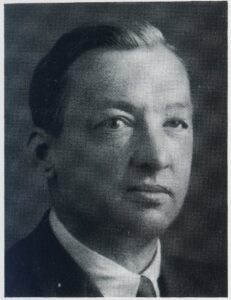
1926: First auction of a Rolls-Royce at Schmohl
On 21 April 1926, the first auction of a Rolls-Royce car took place at Schmohl in Brunau. A six-seater six-cylinder car with a Landaulet body went under the hammer. This design with a half-open, half-closed body was a common reminiscence of coachbuilding at the time, where landaulette carriages were particularly popular in the aristocratic society of the 18th and 19th centuries.
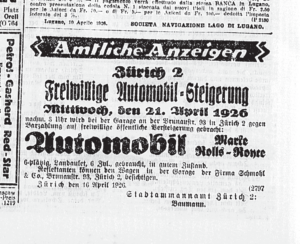
1926: Zurich police command orders a Steyr XII from Schmohl
Schmohl has not only been a trusted address for car repairs of all kinds from the very beginning, but also a successful importer of Steyr automobiles. The former Austrian arms factory had an excellent reputation throughout Europe for its robust and powerful cars; and its successes in the touring races of the Roaring Twenties proved to be excellent advertising. The Zurich Cantonal Police was among the Steyr and Schmohl customers. It already owned a six-seater Steyr when it applied to the Zurich government council for another, more compact version in 1926. The police command justified the application as follows: For one thing, the use of a four-seater allowed operating costs to be halved compared to the six-seater. And secondly, the police command’s cars were repeatedly taken up by other administrative departments of the government council “so that on several occasions they were not available for urgent criminal cases.” The vehicle cost CHF 9,700, “payment (…) for the purchase of the same could be specially agreed with the Schmohl & Cie. factory in Zurich.” On Christmas Eve 1926, the Zurich cantonal government approved the request.
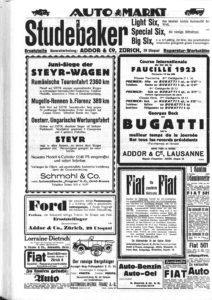
1930: Schmohl adds Nash to its portfolio
The golden twenties also saw the first automobile boom in Switzerland. In the first seven business years of Schmohl & Co., the number of motorised vehicles in the canton of Zurich triples – and Schmohl grows with it. In 1930 Schmohl took over the official representation of the American car manufacturer Nash. This was also a reaction to the fact that Steyr opened its own showroom and sales outlet in Zurich in 1928 due to its success in Switzerland; Schmohl merely acted as a service partner. Nash is another successful brand to join the portfolio. Nash’s chief engineer Mr Wahlberg is a pioneer of wind tunnel testing – the Nash cars were correspondingly streamlined and technically sophisticated, equipped for example with a ventilation system in which outside air is drawn in and heated. Nash’s advertising slogan at the time: “Give the customer more than he has paid for.”
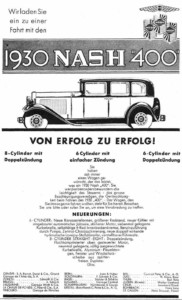
1935: Relocation to Zurich’s Seefeld quarter
In 1930, Schmohl & Co. first relocated to Aussersihl at Gasometerstrasse 9. However, after just under five years, this interlude in the working-class quarter came to an end and Schmohl & Co. found a more suitable location: at Mühlebachstrasse 26 in Zurich’s Seefeld quarter, very close to bourgeois institutions such as the editorial offices of the Neue Zürcher Zeitung on Falkenstrasse and the Zurich City Theatre (now the Opera House). Schmohl & Co. had remained loyal to this location for almost 70 years. Meanwhile, the second generation, namely Georg Schmohl, born in 1908 and named after his grandfather Friedrich Georg, who had once emmigrated to Switzerland from Germany, was also actively involved in the company. Georg worked just as hard as his father – and that was a good thing. Because in 1937, Julius Schmohl died at the age of not even 50. As a result, Georg Schmohl took over the business at the age of 29.
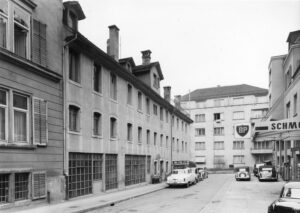
1950: Schmohl became official representative and service partner for Rolls-Royce and Bentley
There were countless car manufacturers in the first heyday of car manufacturing after the First World War. After the boom, however, there was a tough market shakeout. How many people nowadays still know Berna Automobile, the company Julius Schmohl once worked for? Where are the Steyr and Nash brands today? In addition to outstanding technology and quality, the brands that succeed must above all have an identity and occupy a niche. One such niche is luxury, which Georg Schmohl opted for after the Second World War – a far-sighted move, as the heyday of the so-called economic miracle was just around the corner. In 1950 Schmohl became the importer and exclusive service partner of the most luxurious and at the time probably most famous car brand in the world: Rolls-Royce. The sporty subsidiary of Rolls-Royce, Bentley, was also included in the portfolio. The first model for sale was the Rolls-Royce Silver Wraith: “the silver ghost”, which at that time also served as the state coach of Ireland, Brazil and the Danish royal family, for example. Rolls-Royce’s imposing vehicles were also an eye-catcher at motor shows, such as the Silver Cloud III in Geneva in 1963 (picture below).
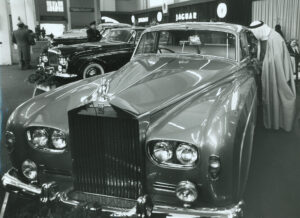
1972: Strong woman: Emmy Schmohl took the wheel
At that time, the wives of successful entrepreneurs usually took care of the household, children and social events. Emmy Schmohl-Müller was not such an entrepreneur’s wife. She has been involved in her husband Georg Schmohl’s family business from the very beginning; as early as 1943, she was granted full authority to legally represent the company as a limited partner and thus unlimited general power of attorney. In the post-war period, the emancipated and enterprising woman became the widely respected grande dame of the Zurich automotive industry at her husband’s side. Almost every year, she traveled to motor shows such as those in Geneva and Frankfurt am
Main or to Rolls-Royce in England, where she and Georg Schmohl were honoured with membership of the exclusive “Order of the Silver Lady” thanks to their outstanding services to Rolls-Royce.
Despite the economic boom, however, Emmy Schmohl-Müller suffered two strokes of fate. In 1968, her older son Georg Jr. was killed in a mountaineering accident on the Titlis. He would have been the third generation of the family to carry on the business. Four years later, in 1972, Emmy Schmohl’s husband Georg died at the age of 64 after a short, serious illness. Emmy Schmohl was forced to take the helm alone – a task she fulfilled with flying colours and was able to count on the support of her long-standing and reliable employees.
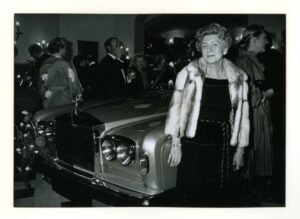
1973: The largest two-door convertible in the world
Schmohl has always had exclusive cars. However, in 1973 Schmohl & Co. sold a particularly exclusive, not to say extravagant vehicle: a Rolls-Royce Phantom VI Cabriolet with special bodywork by Pietro Frua. Let’s start with the basic facts: 6.57 metres long, 2.02 metres wide, 3.68 metres wheelbase. This made this Rolls-Royce the largest two-door convertible in the world at the time – and of course the sensation at the IAA 1973 in Frankfurt am Main. “Next to this, all the other cars looked like toys,” wrote Automobile magazine Auto, Motor und Sport. The boot alone had a “swimming pool format”, noted the editor of the Automobile magazine Automobil Revue. Meanwhile, the
French magazine “L’Automobile” quoted designer Pietro Frua as saying: “When I stood in front of the chassis, I regretted having suggested a convertible based on a lorry.”
It took the legendary designer over two years to satisfy his client Simon van Kempen, Honorary Consul of Monaco, by designing a special model based on a Phantom VI. This was partly due to the extravagant wishes of the consul, who insisted on an angled front bumper, for example, so that the massive bonnet would really come into its own. On the other hand, communication difficulties arose time and again: Pietro Frua did not speak English, the chassis designers at Rolls-Royce did not speak Italian. Schmohl repeatedly had to mediate between designer, client and Rolls-Royce.
Despite all the quarrels: It was worth the effort. For 24 years, the honorary consul would drive his jewel-green “carriage” 400,000 kilometres across the country until he sold it to a Swiss architect in 1997. This also puts the purchase price of 288,000 francs into perspective – the Rolly-Royce cost the consul 20,000 francs per year and 70 centimes per kilometre. That’s not to mention the fact that he was able to sell it on for CHF 570,000.
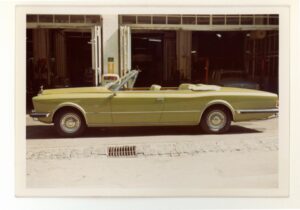
1976: Even sportier
In the spring of 1976, things got sporty at the Schmohl garage in Seefeld: A bright yellow Lancia Stratos HF with the compact dimensions of 3,670 mm length, 1,700 mm width and 1,080 mm height could be found among all the Rolls-Royces and Bentleys, fitting almost twice within in a life-sized Rolls-Royce Phantom and was originally designed for the racing. In 1974, 1975 and 1976, Lancia became world rally champion with the Stratos. The road-going Stradale version accelerated from a standstill to 100 km/h in 6.8 seconds and reached a top speed of almost 250 km/h. There is a good reason why Schmohl & Co. took over the representation for Lancia: Many customers were looking for a smaller, sportier second car in addition to their Rolls-Royce or Bentley.
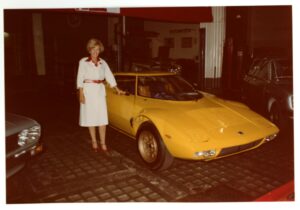
1976: A dozen Rolls-Royces for a Zurich wedding
On 28 August 1976, wedding bells rang out in Zurich’s Grossmünster church. More than a dozen Rolls-Royces decorated with flowers were parked on the cobbled forecourt. One in particular stood out among the Silver Clouds, Silver Shadows, Phantoms and Continentals: an open, silver-grey 1924 20 HP – the “wedding carriage”. Zurich had never seen anything like that. Who were the happy couple?
Emmy Schmohl had suffered enough in recent years – that day was a day to celebrate. After all, she also had something to celebrate: Her son, the doctor Dr Peter Schmohl, married his fiancée Marie-Luise. The Grande Dame of the Zurich car industry had all the available Rolls-Royces decorated in her garage to make an impressive Rolls-Royce convoy possible. She also asked regular customers whether they would make their cars available for the day. Everyone agreed.
It was an unforgettable day – for the wedding couple, for Emmy Schmohl and a little bit for Emily, the nickname given to the famous Rolls-Royce radiator mascot at the time.
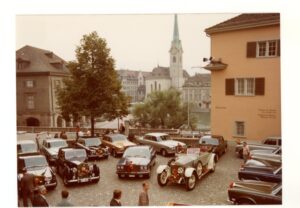
1979: Flying Rolls
Schmohl & Co. AG spared no effort to bring potential customers into contact with its exclusive cars. In 1979, Emmy Schmohl had two Rolls-Royce Silver Shadow IIs hoisted into the lobby of the Palace Hotel in St. Moritz for a special exhibition.
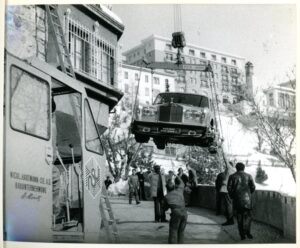
1989: Long-standing employees took over the family business
After more than half a century in the business, Emmy Schmohl, aged 76, had to think about her successor. Workshop manager Alois Elsener and accountant Eveline Elsener (left) had been faithfully assisting her for years and had long since been granted joint authority to legally represent the company. In 1985, the Schmohl & Co. AG under Elsener’s leadership even managed to win the European Service Award from Rolls-Royce (see picture). As a result, on 3 January 1989, Emmy Schmohl and her son Peter resigned from the Board of Directors of Schmohl & Co. AG and transferred their company shares to Mrs and Mr Elsener.
The staff saw the Elseners as managers on an equal footing, who looked after employees and customers with a keen instinct and led the proud family business into the future. Emmy Schmohl died on 11 October 1992, knowing that her life’s work was in reliable hands.
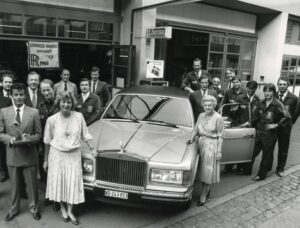
1999: Kamps Gruppe gets on board
At the end of the 1990s, a wave of growth hit the automotive industry, triggered by the emerging BRIC countries of Brazil, Russia, India and China. While these markets were previously rather insignificant for the industry, population growth, increasing economic power and better infrastructures were driving up sales in the BRIC countries. More and more people could afford a car, some even luxury cars.
In order to meet the high volume expectations in these growth markets, car manufacturers were merging into groups and setting high sales targets for brand representatives such as Schmohl & Co: Instead of 30 new vehicles per year, Schmohl now sold 150 – and the trend continued to rise. In order to finance this growth, Schmohl AG needed a strong partner – and found one in the German Kamps Gruppe. Like Schmohl, Kamps Gruppe is a traditional family business with reliable values – and also Germany’s largest private car dealer for the Audi, Porsche and Volkswagen brands. In 1999, Mr and Mrs Elsener sold Schmohl AG to Kamps Gruppe. Gerd Kamps appointed Mathias Hascher, an experienced industry expert and outstanding salesman, as the new Managing Director.
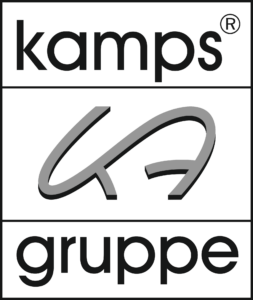
2004: Moving with Lamborghini
Things were getting cramped for Schmohl AG in Zurich Seefeld – mainly because the sales volume has increased fivefold within a short space of time. Schmohl had recently started representing another luxury car brand which, like
Bentley, belongs to the Volkswagen Group: Lamborghini.
The “most expensive meadow in Europe”, the Oberhauser Riet in Opfikon-Glattbrugg with 67 hectares of land, was to be built on at the city limits near Kloten Airport and the A1 motorway. Schmohl AG was the first newcomer to the planned “Glattpark” development, which only existed on the drawing board, and the estate agent responsible proudly announced in the Neue Zürcher Zeitung that “even one of Zurich’s most exclusive artefacts has apparently found its way into the Glattpark (…), the Schmohl garage with all its glory.”
900 guests visited the four-storey glazed exhibition building with its state-of-the-art workshop at the opening ceremony in March 2005. Schmohl created a spectacular show, unveiling the new Bentley Continental Flying Spur and exhibiting the 2003 Le Mans winning car, a Bentley EXP Speed 8 Mk II. And the company had another surprise in store: Schmohl became the only car dealership in Switzerland to represent the French super sports car brand Bugatti, which only produces 50 vehicles a year.
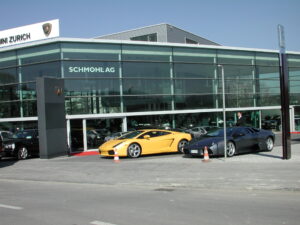
2011: Formula 1 flair
“Life is measured in achievements, not in years alone,” the New Zealand racing driver and four-time Grand Prix winner Bruce McLaren is said to have once said. For Schmohl AG, becoming part of the hand-picked dealer network of the historic Formula 1 brand founded by Bruce McLaren in 1963 was a real “achievement”, a milestone. There are only 35 McLaren sales outlets worldwide, 13 in Europe and one in Switzerland: Schmohl. Schmohl expanded the dealership for McLaren with a new showroom at Stinson-Strasse 2 in Glattpark.
Initially, only the McLaren MP4-12C was on offer. In September 2011, the European Director of McLaren Automotive presented the impressive key figures of the super sports car to guests and media representatives: Like a Formula 1 car, the MP4-12C is largely made of carbon fibre, its 3.8-litre V8 engine with 600 hp accelerates it from 0 to 100 km/h in 3.3 seconds and reaches a top speed of 330. In the British car programme “Top Gear”, the McLaren was even named the “fastest sports car ever tested”. And as if that wasn’t proof enough of McLaren’s racing prowess, next to the MP4-12C in the Schmohl showroom is the unique McLaren of Formula 1 world champion Kimi Räikkönen, in which the Finn won his first Grand Prix in Malaysia in 2003.
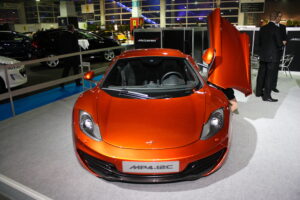
2013: Retirement after a successful career in Glattpark
In June 2013, the automotive industry celebrated an influential personality: Mathias Hascher. As Managing Director of Schmohl AG, he moved from the tranquil Seefeld to the vibrant Glatttal, established professional marketing and always put the customer’s needs at the centre. Since 1999, he had developed Schmohl AG into an agile, customer- and sales-orientated company. And with resounding success: With “fine business acumen” and “great dedication”, Mr Hascher made Bentley Zurich one of the most successful branches in the world, enthuses the international branch portal Bentley Dealer News on his departure.
Some people might have their heads in the clouds with these successes – but certainly not Mr Hascher. Even though he (obviously) drove Rolls-Royces and Bentleys as Managing Director of Schmohl AG, he always remained modest and down-to-earth. Mathias Hascher was always an approachable manager, a man without airs and graces, but all the more popular with employees and customers.
He retired in 2013. His successor was Christoph Haas, who joined Schmohl AG from Harley-Davidson.
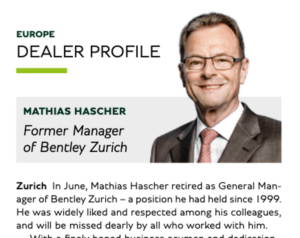
2016: The major reconstruction
The McLaren MP4-12C may be fast, but Schmohl can go even faster: with the Bugatti Chiron, 1,500 hp, 8-litre V16 engine, from 0 to 100 km/h in 2.4 seconds.
The recently launched super sports car was Schmohl’s most photographed gem at the reopening ceremony in autumn 2016. The car dealership was under reconstruction for 14 weeks and finally welcomed 600 journalists and other guests in new splendour. The exhibition area for Bentley alone is as big as two tennis courts. The highlight, however, is the new Bugatti showroom: “Only one of eight in the whole of Europe with a new market presence,” explained the Managing Director of Schmohl AG, Christoph Haas, to those present.
Bugatti’s European Director had also travelled from Alsace, as Switzerland was “the most important market for Bugatti after England and Germany.” Ten per cent of all Bugatti Veyron models, the predecessor of the Chiron, had found their way to Switzerland – in other words around 45 cars. The Chiron, which is limited to 500 units, had already received 200 blind orders. The director kept to himself how many of them came from Switzerland.
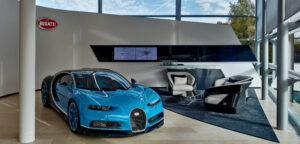
2022: New management, new organisation
After eight successful years, Managing Director Christoph Haas (right) handed over the operational management of Schmohl AG to Management Board member Roderick Pike, most recently Sales & Brands Director at Schmohl.
Mr Haas himself assumed the management of the newly created Kamps Switzerland AG, under whose umbrella the newly founded Schmohl Exclusive Cars AG is managed alongside Schmohl AG – by Group CEO Christoph Haas himself, of course.
Schmohl Exclusive Cars AG operates a new location of its own in Weinfelden as well as the new “Schmohl Exclusive Classic Cars – The Valley” in the Kemptthal industrial estate, where fine classic cars are sold or serviced, repaired
and restored in the excellent workshop. Schmohl’s new group organisation sets the strategic course for further growth and the development of additional business areas in the future.

2023: Stronger than ever
Schmohl AG celebrated its anniversary! To mark its 100th anniversary, the company remodelled the Rolls-Royce showroom and launched eleven special models of the Rolls-Royce, Bentley and McLaren brands in summer 2023. With the all-electric Rolls-Royce Spectre and the Croatian electric sports cars from RIMAC, which Schmohl now represents, the company is preparing itself for the challenges of the future. It has been 100 years since Julius Schmohl founded Schmohl & Co. in Zurich’s Brunau quarter. The world has never changed as much as it has in the last century. On Swiss roads in 1923, the rule of thumb was still often: one carriage, one horsepower – or a few more if the carriage was pulled by a team. Today, all 80,541 horses in Switzerland would not stand a chance against the fleet of vehicles that Schmohl AG sells in a year’s time (2022), even if they were to join forces: 188,794 hp, powering 255 vehicles.





